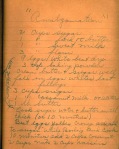Anyone who entrusts you with a family recipe loves you and will give you other instructions like, “Get a job.”
Such memories bind us all, and heirloom recipes should be treasured as reflections of a people and their character. I’m always on the lookout for old recipes from family lines and any dish not mentioned in that harangue of books and magazines devoted to Southern cuisine. Community cookbooks are a fine source of these recipes, but you can bet your bottom dollar that more than a few contributors are simply not going to share essential details because the church secretary was caught sleeping with her brother-in-law.
Some years ago, I found a recipe that stands out: amalgamation cake. Yes, it’s a cake, but amalgamation is a word you usually stumble on in cookery works by dirt road academics purportedly “devoted to” and “enthralled with” Southern foodways. I first heard this cake mentioned by a friend from Tupelo; queries to others brought about a dozen responses, all of them indicating that the amalgamation cake originated from northeast Mississippi and adjacent Alabama.
I felt smug about isolating a true north Mississippi heirloom when someone popped up and pointed out that Ferrol Sams mentions amalgamation cake, “And he’s from Georgia.” Recipes also hail from northwest Tennessee, western South Carolina and a bundt from Florida that seems way off all maps, but they are few. No mention is made of amalgamation cake in “Southern Living”, not in any of Quail Ridge Press’ “Best of the Bests” series, nor in any of my Jackson cookbooks. It is in The Mississippi Cookbook, published by the Mississippi Cooperative Extension Service in 1972, confirming that amalgamation cake is a rural tradition.

Research on the origins of this recipe became a grail quest. The earliest recipe I’ve found is handwritten from Itawamba County in 1939, sent to me by Bob Franks in Fulton. Apparently recipes for amalgamation cake are jealously guarded in families, passed down and shared only with close friends and relatives. True to form, every recipe I received came with stringent instructions to follow; those who shared recipes with me said if I didn’t use fresh coconut that I would die and go to–a deeper level of–hell.
They all told me to get a job, too.
Amalgamation cake is always made for Christmas, and is similar to Alabama’s Lane cake, made famous by its mention in To Kill a Mockingbird. The Lane cake was created by Emma Lane of Clayton, Alabama who published her recipe in 1898. Most recipes for both cakes result in layers of white sponge cake with a filling of raisins, pecans, and coconut. The main difference between a Lane cake, which has it, and and amalgamation cake, which doesn’t, is liquor. The Lane cake, like its cousin the Lady Baltimore, is always infused with bourbon or some such, while the sober amalgamation abstains from spirits. The sole exception to this rule is a recipe from my home county (“Vote dry and drink wet!”) Calhoun, which calls for a sweet wine wrap overnight.
The following recipe was published in The Tuscaloosa News, Nov. 2011, from Billie Ruth Armstrong Moore, a student in the Osher Lifelong Learning Institute’s “Preserving Your Family History” class. Asked to bring in a family recipe and write about it, she wrote:
Granny’s Amalgamation Cake was a favorite dessert at Thanksgiving and Christmas which our extended Armstrong family always celebrated at the home of my grandmother, Georgia Elizabeth Shumpert Armstrong. Her home was located near the Evergreen Community which is in the southwest corner of Itawamba County, Mississippi.
Billie Ruth includes scaly bark hickory nuts, a distinctively native ingredient. White raisins were mentioned as a refinement, and seven minute frosting is standard.
BATTER
1 1⁄2 cups sugar
1⁄2 cup Crisco
3 eggs (or 9 egg whites)
1 cup milk
2 1⁄2 cups plain flour
2 teaspoons baking powder
1 teaspoon vanilla flavoring
FILLING
9 egg yolks
2 cups sugar
1 3⁄4 cups milk
1⁄4 pound butter
1 15-ounce box raisins
1 1⁄2 cups mixed nuts (1 cup pecans and 1⁄2 cup scaly barks)
1 big coconut, grated
Bake batter in 2 or three layers. For filling, beat egg yolks well, and then add sugar, milk and butter. Mix well and cook on medium heat until thickened slightly. Add raisins and nuts, cook until thick, add coconut last. Beat well, cool, spread between layers, then assemble and frost cake. Let rest several hours–overnight if possible–before serving.

